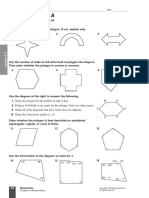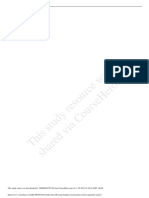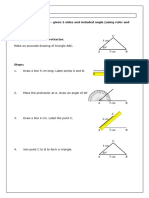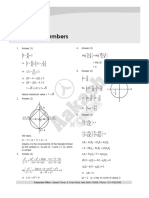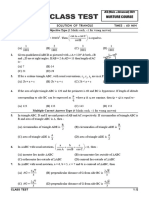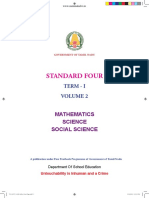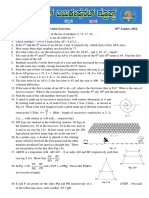Circle Constructions - Student Guide - Part 2
Circle Constructions - Student Guide - Part 2
Uploaded by
Malachi MillerCopyright:
Available Formats
Circle Constructions - Student Guide - Part 2
Circle Constructions - Student Guide - Part 2
Uploaded by
Malachi MillerOriginal Title
Copyright
Available Formats
Share this document
Did you find this document useful?
Is this content inappropriate?
Copyright:
Available Formats
Circle Constructions - Student Guide - Part 2
Circle Constructions - Student Guide - Part 2
Uploaded by
Malachi MillerCopyright:
Available Formats
Circle Constructions – Part 2
Student Guide
Geometric Constructions
Geometric constructions date back thousands of years to when Euclid, a Greek mathematician known as
the “Father of Geometry,” wrote the book Elements. In Elements, Euclid formulated the five postulates
that form the base for Euclidean geometry. To create all the figures and diagrams, Euclid used
construction techniques extensively. A compass and straightedge are used to create constructions. A
compass is used to draw circles or arcs and a straightedge is used to draw straight lines.
As you complete the task, keep these questions in mind:
How do you perform constructions related to circles? What theorems and explanations can be
used to justify these constructions?
In this task, you will apply what you have learned in this lesson to answer these questions.
Directions
Complete each of the following tasks, reading the directions carefully as you go. Be sure to show all work
where indicated, including inserting images of constructions created using the tool. If you are unable to
take and insert screenshots of the construction tool, print this activity sheet and create the constructions
by hand using a compass and straightedge.
In addition to the answers you determine, you will be graded based on the work you show, or your
solution process. So, be sure to show all your work and answer each question as you complete the task.
Type all your work into this document so you can submit it to your teacher for a grade. You will be given
partial credit based on the work you show and the completeness and accuracy of your explanations.
Your teacher will give you further directions about how to submit your work. You may be asked to upload
the document, e-mail it to your teacher, or print it and hand in a hard copy.
Now, let’s get started!
Copyright © Edgenuity Inc.
Student Guide (continued)
Step 1: Construct a circle through three points not on a line.
a) Points D, E, and F are not in a line. To construct a circle through points D, E, and F, begin by
drawing line segmentsDE ´ and EF ´ . Then construct the perpendicular bisectors of DE
´ and EF ´ ,
and name the point of intersection of the perpendicular bisectors O. How do you know that point
O is the center of the circle that passes through the three points? (10 points)
Copyright © Edgenuity Inc.
Student Guide (continued)
Step 2: Construct regular polygons inscribed in a circle.
a) While constructing an equilateral triangle or a regular hexagon inscribed in a circle, you may have
noticed that several smaller equilateral triangles are formed, like PQR shown in the figure
below. Explain why PQR is an equilateral triangle. (5 points)
b) The completed construction of a regular hexagon is shown below. Explain why ACF is a 30º-
60º-90º triangle. (10 points)
B
A
C
M
F
D
E
Copyright © Edgenuity Inc.
Student Guide (continued)
c) If you are given a circle with center C, how do you locate the vertices of a square inscribed in
circle C? (5 points)
Step 3: Construct tangent lines to a circle.
a) ´ is a diameter of circle K. If tangents to circle K are constructed through points L and J, what
JL
relationship would exist between the two tangents? Explain. (5 points)
Copyright © Edgenuity Inc.
Student Guide (continued)
b) The construction of a tangent to a circle given a point outside the circle can be justified using the
second corollary to the inscribed angle theorem. An alternative proof of this construction is shown
below. Complete the proof. (5 points)
´ is a radius of circle C.
Given: Circle C is constructed so that CD = DE = AD; CA
Prove: ´ is tangent to circle C.
AE
E
Reasons
D
C
Statements
1. Circle C is constructed so that CD = DE = AD; 1. Given
´ is a radius of circle C.
CA
2. ´ ≅ DE
CD ´ ≅ AD
´ 2. Definition of congruence
3. ACD is an isosceles triangle; 3.
ADE is an isosceles triangle.
4. 4.
m ∠CAD + m ∠DCA + m ∠ADC = 180°;
m ∠DAE + m ∠ AED + m ∠EDA = 180°
5. 5. Isosceles triangle theorem
6. m ∠CAD = m ∠DCA ; 6. Definition of congruence
m ∠DAE = m ∠ AED
7. 7. Substitution property
m ∠CAD + m ∠CAD + m ∠ ADC = 180°;
m ∠DAE + m ∠DAE + m ∠ EDA = 180°
8. 2 ( m ∠CAD ) + m ∠ ADC = 180°; 8. Addition
2 ( m ∠DAE ) + m ∠EDA = 180°
9. m ∠ ADC = 180° – 2 ( m ∠CAD );
9.
m ∠ EDA = 180° – 2 ( m ∠DAE )
10. ∠ ADC and ∠ EDA are a linear pair. 10.
Copyright © Edgenuity Inc.
Student Guide (continued)
11. 11. Linear pair postulate
12. m ∠ ADC + m ∠ EDA = 180° 12. Definition of supplementary
angles
13. 1 13. Substitution property
80° – 2 ( m ∠CAD ) +180° – 2 ( m ∠DAE )=180°
14. 360° – 2 ( m ∠ CAD ) – 2 ( m ∠DAE ) =180° 14. Addition
15. – 2 ( m ∠ CAD) – 2 ( m ∠DAE )=−180° 15. Subtraction property
16. m ∠CAD + m ∠DAE=90° 16.
17. m ∠CAD + m ∠ DAE = m ∠CAE 17. Angle addition postulate
18. 18. Substitution property
19. ∠ CAE is a right angle. 19. Definition of right angle
20. 20. Definition of perpendicular
21. ´ is tangent to circle C.
AE 21.
Copyright © Edgenuity Inc.
You might also like
- The Subtle Art of Not Giving a F*ck: A Counterintuitive Approach to Living a Good LifeFrom EverandThe Subtle Art of Not Giving a F*ck: A Counterintuitive Approach to Living a Good LifeRating: 4 out of 5 stars4/5 (5991)
- The Gifts of Imperfection: Let Go of Who You Think You're Supposed to Be and Embrace Who You AreFrom EverandThe Gifts of Imperfection: Let Go of Who You Think You're Supposed to Be and Embrace Who You AreRating: 4 out of 5 stars4/5 (1112)
- Never Split the Difference: Negotiating As If Your Life Depended On ItFrom EverandNever Split the Difference: Negotiating As If Your Life Depended On ItRating: 4.5 out of 5 stars4.5/5 (899)
- Hidden Figures: The American Dream and the Untold Story of the Black Women Mathematicians Who Helped Win the Space RaceFrom EverandHidden Figures: The American Dream and the Untold Story of the Black Women Mathematicians Who Helped Win the Space RaceRating: 4 out of 5 stars4/5 (932)
- Grit: The Power of Passion and PerseveranceFrom EverandGrit: The Power of Passion and PerseveranceRating: 4 out of 5 stars4/5 (619)
- Shoe Dog: A Memoir by the Creator of NikeFrom EverandShoe Dog: A Memoir by the Creator of NikeRating: 4.5 out of 5 stars4.5/5 (546)
- The Hard Thing About Hard Things: Building a Business When There Are No Easy AnswersFrom EverandThe Hard Thing About Hard Things: Building a Business When There Are No Easy AnswersRating: 4.5 out of 5 stars4.5/5 (357)
- Her Body and Other Parties: StoriesFrom EverandHer Body and Other Parties: StoriesRating: 4 out of 5 stars4/5 (831)
- Elon Musk: Tesla, SpaceX, and the Quest for a Fantastic FutureFrom EverandElon Musk: Tesla, SpaceX, and the Quest for a Fantastic FutureRating: 4.5 out of 5 stars4.5/5 (477)
- The Emperor of All Maladies: A Biography of CancerFrom EverandThe Emperor of All Maladies: A Biography of CancerRating: 4.5 out of 5 stars4.5/5 (275)
- The Little Book of Hygge: Danish Secrets to Happy LivingFrom EverandThe Little Book of Hygge: Danish Secrets to Happy LivingRating: 3.5 out of 5 stars3.5/5 (426)
- The World Is Flat 3.0: A Brief History of the Twenty-first CenturyFrom EverandThe World Is Flat 3.0: A Brief History of the Twenty-first CenturyRating: 3.5 out of 5 stars3.5/5 (2281)
- The Yellow House: A Memoir (2019 National Book Award Winner)From EverandThe Yellow House: A Memoir (2019 National Book Award Winner)Rating: 4 out of 5 stars4/5 (99)
- The Sympathizer: A Novel (Pulitzer Prize for Fiction)From EverandThe Sympathizer: A Novel (Pulitzer Prize for Fiction)Rating: 4.5 out of 5 stars4.5/5 (125)
- Devil in the Grove: Thurgood Marshall, the Groveland Boys, and the Dawn of a New AmericaFrom EverandDevil in the Grove: Thurgood Marshall, the Groveland Boys, and the Dawn of a New AmericaRating: 4.5 out of 5 stars4.5/5 (270)
- A Heartbreaking Work Of Staggering Genius: A Memoir Based on a True StoryFrom EverandA Heartbreaking Work Of Staggering Genius: A Memoir Based on a True StoryRating: 3.5 out of 5 stars3.5/5 (232)
- Team of Rivals: The Political Genius of Abraham LincolnFrom EverandTeam of Rivals: The Political Genius of Abraham LincolnRating: 4.5 out of 5 stars4.5/5 (235)
- On Fire: The (Burning) Case for a Green New DealFrom EverandOn Fire: The (Burning) Case for a Green New DealRating: 4 out of 5 stars4/5 (75)
- Geometry Chapter 6 WorksheetsDocument6 pagesGeometry Chapter 6 Worksheetsapi-3067202130% (1)
- March Camp 2019 GeometryDocument80 pagesMarch Camp 2019 GeometryNguyễn Công ThànhNo ratings yet
- The Unwinding: An Inner History of the New AmericaFrom EverandThe Unwinding: An Inner History of the New AmericaRating: 4 out of 5 stars4/5 (45)
- Consider The Following Triangle Classification System Originally UsDocument3 pagesConsider The Following Triangle Classification System Originally UsCandace LeeNo ratings yet
- Maths Project For Class 10Document18 pagesMaths Project For Class 10John Nguyen58% (43)
- Geometry-Solutions 3 PDFDocument5 pagesGeometry-Solutions 3 PDFสฮาบูดีน สาและNo ratings yet
- JMO Geometry Questions: Level: Junior Ref No: J03 Puzz Points: 12Document8 pagesJMO Geometry Questions: Level: Junior Ref No: J03 Puzz Points: 12Valdrin Ejupi0% (1)
- MATH4 - Q3 - M3 - Identifying and Describing Triangles and QuadrilateralsDocument9 pagesMATH4 - Q3 - M3 - Identifying and Describing Triangles and Quadrilateralsrimbe garridoNo ratings yet
- Class X Chapter 19 - Constructions (Circles) Maths: Book Name: Selina ConciseDocument13 pagesClass X Chapter 19 - Constructions (Circles) Maths: Book Name: Selina ConciseSANDEEP SINGHNo ratings yet
- TG New 4th RatingDocument80 pagesTG New 4th RatingericmilamattimNo ratings yet
- ExamView - Circles Quiz 1 ReviewDocument9 pagesExamView - Circles Quiz 1 ReviewSlowed and ReverbedNo ratings yet
- Analytic Geometry 1Document2 pagesAnalytic Geometry 1Lemuel TeopeNo ratings yet
- Worksheet Pack Constructions Triangles and HexagonsDocument5 pagesWorksheet Pack Constructions Triangles and HexagonsMahboob RiazNo ratings yet
- MATH10-QUARTER2-MODULE7-Solving Problems On CirclesDocument26 pagesMATH10-QUARTER2-MODULE7-Solving Problems On CirclesDreyzen Ganotisi100% (2)
- Solid Mensuration ReviewerDocument7 pagesSolid Mensuration Reviewertrifoldzee03No ratings yet
- 10 - Dot SituationDocument4 pages10 - Dot SituationJiyaNo ratings yet
- AMTI (NMTC) - 2004: Ramanujan Contest - Inter LevelDocument25 pagesAMTI (NMTC) - 2004: Ramanujan Contest - Inter Levelasha jalan100% (1)
- Complex Numbers Archive SolutionsDocument19 pagesComplex Numbers Archive Solutionsmeghanadhk30No ratings yet
- Elementary Triangle Geometry (Mark Dabbs)Document77 pagesElementary Triangle Geometry (Mark Dabbs)jvr84100% (1)
- Class Test-5 SotDocument2 pagesClass Test-5 Sothumdobhaidonotabahi126No ratings yet
- Namma Kalvi 4th Maths, Science and Social Science Book EM Term 1Document160 pagesNamma Kalvi 4th Maths, Science and Social Science Book EM Term 1Priya DharshiniNo ratings yet
- Unit 3 Answer Key MathDocument7 pagesUnit 3 Answer Key MathJood KhunjiNo ratings yet
- Mtap G6S5 With TGDocument5 pagesMtap G6S5 With TGLuis SalengaNo ratings yet
- Grade X Math Worksheet Revision Exercises 18.8.22Document4 pagesGrade X Math Worksheet Revision Exercises 18.8.22Shivakumar ShivakumarNo ratings yet
- Mathematics - Class 6 CH - 5Document35 pagesMathematics - Class 6 CH - 5RUPali KUMARINo ratings yet
- Instruction: This Question Paper Consists of 40 Questions. Answer All Questions. EachDocument12 pagesInstruction: This Question Paper Consists of 40 Questions. Answer All Questions. EachDesmondNo ratings yet
- Maths - Chapter Wise Ib QuestionsDocument18 pagesMaths - Chapter Wise Ib QuestionsMyraNo ratings yet
- Unit 2.1 - Area and Volumes of Geometric FiguresDocument62 pagesUnit 2.1 - Area and Volumes of Geometric FiguresAdrian Monteclaro100% (1)
- Grade 10 Trigonometry IdDocument10 pagesGrade 10 Trigonometry IdDjemi SiswantoNo ratings yet
- SP - CHP 02 - Surveying MathematicsDocument67 pagesSP - CHP 02 - Surveying MathematicsanittamariaroNo ratings yet
- Aman Projection of PlanesDocument10 pagesAman Projection of PlanesAman ShettyNo ratings yet






































